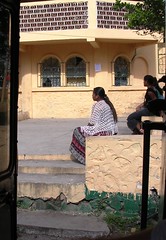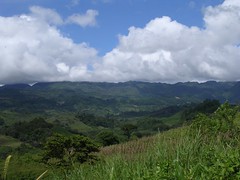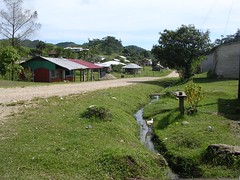The song of the jungle awakes us very early and while we have breakfast we are wrapped by a misty fog. In our mind slide fast the memories of three months spent in Mexico, looks and smiles of the people known or just grazed… crossing the frontier between Mexico and Guatemala do not involve the tragic intensity of travelling from the United States to Mexico: simply we move on the other side of the river Usumacinta, from Frontera Corozal to Bethel. Here we find again the same jungle, the same bajareques (houses of wood and adobe, a mix of mud and straw), the same pleasant smiles. The unpaved, muddy road drives us along green grasses and hills, until the lake of Petèn Itzà. We start to notice the first differences with Mexico, the first days in an unknown country are always the most difficult, but also the most stimulating. Walking between the island of Flores and the pueblo of Santa Elena, we breathe an Asian atmosphere, even if it’s an image that lasts for a second: a lot of powder and hundreds of “risciò” and small vehicles adapted to the transport of passengers.
Frontera Corozal, Lacandon jungle
The last Mexican night flies away slowly but inexorably, like the course of the rio Usumacinta, where we are staying now. The road that has lead us from the highlands near Comitàn to Frontera Corozal, it is a hard way through an incredible landscape. After the wonderful Lagunas de Montebello, some blue and green emerald lakes encircled by pines, the road falls down towards the jungle, along the border with Guatemala. That’s why it is called “carretera fronteriza”. Until the village of Benemerito de Las Americas, we observe the fruit of decades of totally irrational exploitation of the territory. With the promise of an easy land, the campesinos from the highlands were sent here (see the experience of ejido Emiliano Zapata), every time deeper in the heart of the Lacandon jungle. But the absence of a clever agricultural project forced to an extensive and unproductive exploitation of the land. As dramatic consequence, we see a forest in agony and the return of the large estate owners, in places where they could never have arrived even with enormous resources. Frontera Corozal isn’t free from these problems, but its inhabitants seem to have found a valid alternative in projects of “ecotourism”, thanks to the beauty of the river Usumacinta and the wealth of life along its sides (finally we have seen the howler monkeys!). Moreover a few kilometers from the community there are Mayan ruins such as Yaxchilan and Bonampak.
Towards the Lacandon Jungle
Second part. It’s early in the morning, but the emotion keep us wide awake: we put all our dreams on the “camioneta” that will take us to San Quintin, ready to share them with the other people who undertake the travel towards the Lacandon jungle with us. Left Ocosingo, the road sweetly follows the valleys covered by pines and corn fields… we go down slowly, the air gets more humid and the forest becomes more and more green. The unpaved and muddy road pushes us through small villages, from the wooden huts appear the looks astonished but curious of the children. Exceeded the caracol zapatista of Francisco Gomez, the pines leave space to the jungle and begins to rain. Late in the evening we finally reach Saint Quintin, where the road finishes: the feeling is to find a confused and disordered community. Therefore, we decide to walk until ejido Emiliano Zapata, where the “Secretario de turismo”, Adolfo receives us. We are lodged in a splendid cabaña close to the river, surrounded by the jungle and the howls of its animals. After a short swim in the river, we eat with other three boys in the house of señor Manuèl, his wife prepares us a delicious “pollo en mole”, cooked on firewood. We are very tired and in the dark of the jungle we fall aslept without offering resistance.
Indigenous communities of Chiapas
First part. During the period spent in Ocosingo, we have been observers of a hard but intense life. Day after day, people became more and more friendly and the last evening we knew a family coming from a pueblo on the road to San Cristobal, all together with the father who sold candies in the public square. The mother, a very young woman, was so proud of her five sons and she had all the reasons as they were beautiful, curious and friendly. We passed all the evening playing with them… we think that the concept of poverty cannot be defined in absolute terms: happiness is to be astonished and smile for the simplest things and those three children transmitted us this feeling. Every community, every people should be able to satisfy its elementary needs (food, water, health and peace) following the road traced from its own history and culture. Freedom is not for anyone!
The story that follows comes from our experience in the Lacandon Forest (“Selva Lacandona”), to tightened contact with some indigenous communities of Chiapas: a few days that however allowed us to graze an authentic, unforgettable and sometimes extremely contradictory situation.



